#renationalizing
Text
Stranger plays with wife's big tits in a car while husband drive and film
Amateur Atlanta MILF
NubileFilms Hot girlfriends ass to ass on glass dildo
Girls on fire smothering chap in female domination xxx play
Muscular dude fucks a horny slut without mercy
Co hau gai xinh dep full
Blonde Teen Gets Her Ass Stretched by a Big Dick
Biggest Mushroom Cock Ever
Young boy anal gay sex with old men Caleb Calipso is a horny young
Sexy czech nympho spreads her tight cunt to the strange
#municipia#conveyorized#rebuttoned#wacko#anhang#Idotheidae#chum#weirder#privileger#anathematize#evection#Scarlett#outlearn#byrlawman#literatus#justin#Henke#depilous#renationalizing#colourability
0 notes
Text
While Marx often shows enthusiasm for the potentiality of enhanced forms of human cooperation enabled by globalizing production, already in the nineteenth century, he observed an antagonistic separation of town and country and suggested that production chains were overstretched and wasting resources. Today, lessening the spatial disjuncture between production and consumption must be an explicit feature and aim of sustainable and just transition and, in this context, calls on the left for partial deglobalization, including the shortening of commodity chains, have merit and are quite consistent with Marx’s analysis. In a process of partial deglobalization, production for local and domestic needs—rather than production for export—would again become the center of gravity of the economy. A move away from the export orientation of domestic corporations and a process of renationalization could also allow enterprises to begin to develop their own strategies, moving away from the whims of the global market and choices taken by corporate controllers.
Such transformation could enable spaces for independent development in the Global South. To do so, they could focus on shifting agrarian systems, orienting their production away from agro-export (which is a source of tremendous ecological irrationality and unequal exchange) toward food sovereignty. Such shifts would need to be accompanied by simultaneous, coordinated shifts toward enhanced local and domestic food production in Global North, alongside a move from high-input agriculture to agroecology, and, in settler colonial contexts, enhanced Indigenous sovereignty. Within domestic spaces or regions, efforts must simultaneously be made to mend a rift between the city and the country. For a model of the environmentalist city, one could look to Havana for inspiration. During Cuba’s Special Period in the 1990s, organic, low-input agriculture was developed both in the countryside, as well as in the island’s capital through urban farms. Urban agriculture is here not niche or small-scale—it covers large expanses within and at the outskirts of the city, where rich land is located. In the transition to renewables, energy production should also be localized as much as possible. This is a potentiality inherent in renewable energy “flow,” in contrast to concentrated energy “stock,” or fossil fuels.
While lessening the spatial disjuncture between production and consumption is part of developing ecologically rational production, this aim should be recognized to be in some tension with economic planning (at least in the longer term), insofar as expansive planning is potentiated by the socialization of production. Thus, calls for localization of production imply a diminishment in productive association across firms and regions and the potential to plan such interconnections.
Practically, it is important to recognize that such a process confronts material interdependencies, as existing productive networks and infrastructural configurations support and sustain huge swaths of human life. Different regions and cities also have different specializations and different ecological capacities. In an existing world of evolved economic interdependencies, the reproductive needs of various communities require continued global resource flows. Climate change also creates severe survival and livelihood challenges on a highly uneven basis, and global trade and divisions of labor can act as safeguards against issues such as pandemics related to water-supply failures and reduced agricultural yields. More broadly, we should carefully consider Marx’s suggestion that well-organized territorial divisions of labor are collective powers and can be a part of collaboration in human affairs. This extends to territorial specialization, which, consciously organized, could involve a collaborative partitioning of resources and capacities.
37 notes
·
View notes
Text
No. 47 - MALÉV Hungarian Airlines

MALÉV Hungarian Airlines (Magyar Légiközlekedési Vállalat) was the flag carrier of Hungary until its dissolution in 2012. I'm excited to talk about MALÉV for a couple of reasons. I'll get into those later, when they come up, so let's cut off the preamble and talk about an airline sadly lost to recent history after 66 years in operation, leaving in its place...
Well, nothing, actually. Hungary no longer has a flag carrier, thanks to MALÉV's rather catastrophic end, and Budapest is now primarily served by ULCCs like Ryanair and Wizz Air. It's a very tragic thing, in my opinion, for a country to lose its flag carrier, and I hope that MALÉV, or something else to replace it, will be (re)established at some point, but for the moment it's a beautiful relic of a less financially tempestuous time.

MALÉV's legacy is well-kept, with the Budapest Aeropark open-air museum containing many more preserved aircraft than a lot of extinct airlines will see. Clearly, this airline was dear to a country.
While I never got to fly on MALÉV, I'm excited to cover this airline's eclectic little fleet, which does one thing I can't pretend for a moment doesn't immediately make me eager to discuss an airline:
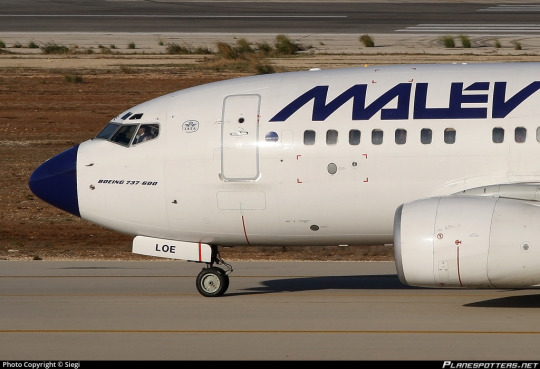
When MALÉV folded, Hungary lost a symbol of national pride, but the rest of us lost something too: one of the rapidly-dwindling number still fighting for the long-lost cause of the painted nose radome.
MALÉV was founded in 1946 as MASZOVLET (Magyar-Szovjet Polgári Légiforgalmi Rt.), born from the merger of a handful of similarly acronymic pre-war Hungarian airlines, plus the Hungarian branch of Aeroflot. It was renamed to MALÉV in 1954, when the Hungarian government bought out all the remaining Soviet involvement in the airline, making it a fully nationalized company. It was 'privatized' in 1993, but the majority of ownership was split between a government-owned holding company and the employees, with the government seemingly intent on privatizing it properly throughout. From 1999 to 2003 its CEO was actually József János Váradi, who is probably better known as the founder and CEO of Wizz Air. It was then sold to Russian airline-alliance-slash-joint-management-company AirBridge (later known as AiRUnion), a LATAM-without-rebranding-ish thing which existed for all of a couple years until it went under in 2008, all of its member airlines, classics like Domedovo and KrasAir also defunct. It was briefly under minority ownership by Vneshekonombank (now VEB.RF), a Russian corporation meant to invest in the development of urban infrastructure, but then renationalized by Hungary. During this period of privatization it underwent an elaborate game of CEO musical chairs, broadly struggling and being subsidized heavily by the Hungarian government. Once this happened the EU ruled that said state aid was actually illegal, and forced MALÉV to repay the years of assistance which had kept it above water - which of course promptly killed it, being more than a year of its revenue.
I dislike this pretty broadly. I'm actually of the opinion that flag carriers shouldn't be privatized at all, and it feels like it frequently makes things immediately and dramatically worse. This isn't really the place for pontification, but MALEV's downfall makes me genuinely sad. It feels almost vindictive in its drama and suddenness, and it killed something legitimately important to both infrastructure and national identity. (Also, I find it hard to wrap my head around the government's determination to privatize MALÉV when they ended up pouring so much money into it anyway.)
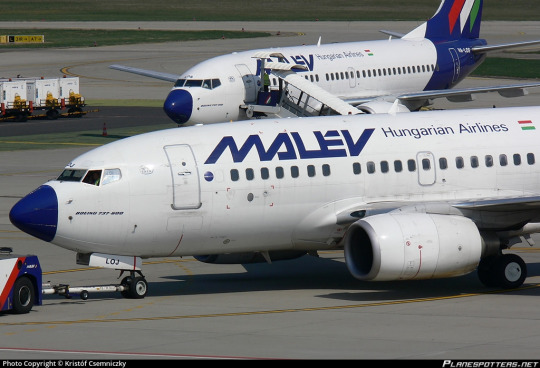
While other airlines eventually picked up the slack, in the immediate aftermath traffic at Budapest Liszt Ferenc International Airport immediately and drastically dropped, and now the only real choices, in a lot of cases, are Wizz Air and Ryanair. Which is broadly fine, I mean, I frequently can't afford anything else, but it's a bit uninspiring for the only option. It's just outright depressing when two airlines operate the vast majority of flights at any airport, with barely any other airlines offering even three, and those two airlines are Ryanair and Wizz Air, especially when you're just smack in the middle of Europe the way Hungary is and are a pretty easy place to route flights through. Increased range on airplanes is obviously a huge benefit to many people, but I'm getting the sense it may have been a cruel joke the universe saw fit to play on Hungarians.

There are three rows of Wizz Air destinations cut off, by the way.
But, okay, enough of that. I'm here for the livery. MALÉV has had three-ish main liveries, from their early days flying the Lisunov Li-2 (a Soviet license-built DC-3) all the way up to their final shuttering.

Yes, that's right - HA-LIX "Kármán Tódor" is in fact an airworthy Li-2![1]
I'm trying to keep my posts at a length that is manageable to both write and read, so I won't be fully covering all the MALÉV liveries. I'm going to assume any requests are for the most up-to-date version unless specified otherwise. But I do just need to mention that I really want to do a follow-up post on MALÉV's original livery, which I think is a standout from its era - just brushing over it in a general history summary doesn't do it justice. It's modeled below on the Ilyushin Il-14 registered HA-MAL, preserved at Aeropark, while the 1968-1986 livery is modeled on this period photograph of Tupolev Tu-134A HA-LBG.


This is another reason I'm very excited by the MALÉV request. Hungary was, if you will, the sort of country which purchased Tupolev airliners, which means I get to use pictures of and talk about old Soviet models! MALÉV began switching to Western planes in the 80s and withdrew their last Tu-154s in the early 2000s, so they're not necessarily the majority of examples, but I do sort of favor the Tupolevs when I can. They're just very idiosyncratic for someone used to looking at mostly Western aircraft, which is to say basically anyone born in the 90s or later. HA-LBG is a Tu-134A, which you can tell because of the glazed nose. Why the glazed nose? Well, that's the classic Soviet navigator pit!
Unfortunately, the later MALÉV Tu-134s had modern nose radomes, visually indistinct from the fuselage around them. Thankfully, I am finally getting to the actual subject of the damned post, which is that in their last-ever livery, designed by László Zsótér[2] and introduced in 1986, MALÉV remembered where they came from and decided they were going to bring back a trend that should never have gone away.

Why did airlines stop painting the noses of their planes? That's a rhetorical question, they stopped doing it because technology had improved to the point they could use other colors on the radome without interfering with the weather radar's function, but, like, why did they stop doing it? Just look at this. The painted nose adds to a feeling of weight and forward momentum, and now the plane looks like a shuttlecock being launched directly at your face during a game of badminton against someone who dislikes you and is sincerely trying to cause you physical injury. She looks like a throwing dart for giants.

Or like a crayon, maybe, also for giants, especially with the stubbier 737 models MALÉV liked to use. The dark color is also very distinctly beaklike.

For some reason, it really immediately and vividly reminds me of the signature beak thing the drag queen Abhora (of Dragula fame) does. I absolutely love it in both cases, though thankfully to the best of my knowledge MALÉV did not embody horror, filth, and glamor.

It does, however, create quite a startling effect via the contrast between white and near-black blue. I will say that this color scheme makes the plane look a bit...villainous? I like that a lot because I'm twisted in the head. The thing that comes to mind is that this plane is haglike. And I love that for her. But I get that this statement could potentially read as insulting, so just, you know, I do mean it as a compliment. I like that she's a hag. I mean, I'm a Siouxsie and the Banshees fan, I'm no stranger to the power of big dark blocks[3].
I think the choice in color here is absolutely fascinating. You see, the Hungarian flag looks like this.

For a regular three-stripe flag I quite like Hungary's dustier take on the archetype, but we can't get around the fact that green, red, and white is an incredibly common combination. Probably in large part due to this, these are also some of the most oversaturated colors in livery design.

Here are just some of the examples that came to mind - and that's not including similar but not identical schemes[5]. These color schemes can obviously still work (two of these liveries are among my favorite examples of Eurowhite done Euro-right, guess which!) but I think MALÉV made the right choice in not trying to compete with it.

It's kind of interesting, though, how instead of just rejecting it altogether (as Mexican flag carrier Aeroméxico has done, as just one example) they picked a very dark off-black shade but then incorporated the colors of the Hungarian flag. This could very easily have gone phenomenally bad but I think it worked for them. It draws interest to the tail (while the blue background keeps it from being detached), the angular use of lines goes with the similar sharpness of the wordmark, and the muted shades Hungary in particular has to work with suit the generally washed-out scheme of this livery.
And to be clear, I don't mean washed-out as an insult. You could easily be fooled into thinking I dislike desaturation based on my reviews here, but I actually really love it and my main long-term non-Runway-Runway project has stylized desaturation as a core feature of its style guide, so to speak. So let me talk about desaturation! The reason desaturation is so frequently ugly is that people use desaturated colors the same way they would use vivid ones and expect it to get the same result, which it obviously won't. The most important thing for use of desaturated colors, in my own opinion, is maintaining very strong contrast. MALÉV does this, obviously, and the flag honestly lends itself to this via the white stripe's placement in the middle, and to a lesser extent the placement of these colors to break up the dark tail. Interesting designs can be subtle, but minimalism only works when it is an active choice designed to create an impression of minimalism (Vietnam Airlines) rather than a blank space (Lufthansa).
The more similar in hue and brightness to each other desaturated colors are, the more the entire thing starts to look flat. MALÉV avoids this by using green, red, blue, and white, which are completely distinct colors. It also creates a certain staccato impression via the sectioning off of the nose, the sharp lines of the wordmark, and the just-as-sharp lines of the tail. This is the point where I have to bring up that this livery was designed for, in large part, Tu-134s and Tu-154s, and these planes are themselves very visually sharp. While they have a very streamlined appearance without question, their planform actually, to me, suits the style of MALÉV's livery better than some of the other types they used, and may explain a bit more why it was designed how it was.

The wing sweep on the Tu-134 is 35 degrees, which is very unusually aggressive even for a rear-engined t-tail plane. I find that the less swept an airplane's wing is, the less it breaks up the line of the fuselage. The Tu-134 is also a bit of a short-looking plane, vertically, relative to a lot of other models, and the straight downward line blocks off the very square tail quite nicely behind the engines, which add some visual interest where they overlap. This sort of scheme looks pretty alright on the Tu-134, even if I think it could use a bit of an adjustment to the wordmark - make it larger, or maybe add an accent color. That would add a bit more weight to the front of the plane.
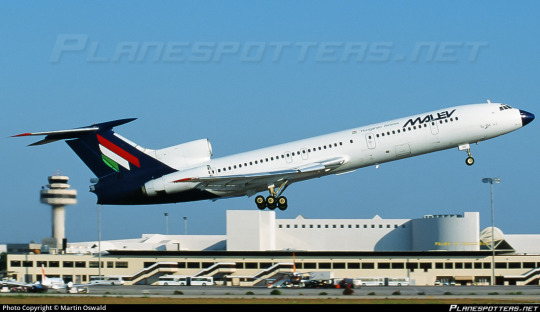
Unfortunately, on a somewhat longer-looking plane like the Tu-154 the white fuselage expanse becomes quite a bit more stark. That staggering just isn't enough to avoid the desolate feeling.


It gets even worse with modern Western planes, which lack the almost violent wing sweep, sharpness, and short fuselage of the Tu-134. MALÉV operated both the 767 and the 737-800, and these just don't have enough visual interest in the center to keep the plane from being a big white sausage. Plus, Boeing noses are pointy, but they're not as pointy as Tupolev noses, which means the nose paint covers less space. This is nearing the Lufthansa Line, which is my new term for the point where a plane has so little happening anywhere except the back that it looks distinctly rear-heavy.
(As well as crossing the Lufthansa Line as a sort of event horizon, the 'Lufthansa Line' can also refer to the literal shape of the straight line downwards. The similar practice which utilizes a curve instead of a straight line is the Lufthansa Line, SAS Variation. The Lufthansa Dec-lined - no, I'll stop. I need to maintain a tiny bit of dignity so I can still make fun of jetBlue without being a hypocrite.)

Like most liveries which straddle or cross the Lufthansa Line, this looks completely fine and proportional on a plane which is sufficiently short and/or stubby to reduce the ratio of rear to full body to around one-third, and the more stretch you add the worse it looks.

A short-looking fuselage like that of the Q400 also mitigates the effect a little. Plus, they do something I keep telling operators of planes with this sort of square tail to do - extend the paint to more of the fuselage, rather than keeping it a straight line. It just unfortunately isn't quite enough, though the pointy nose, shortness, and slight extension definitely mitigates the effect enough that I think it's...very nearly acceptable.
The incredible thing is that MALÉV actually solves this problem!

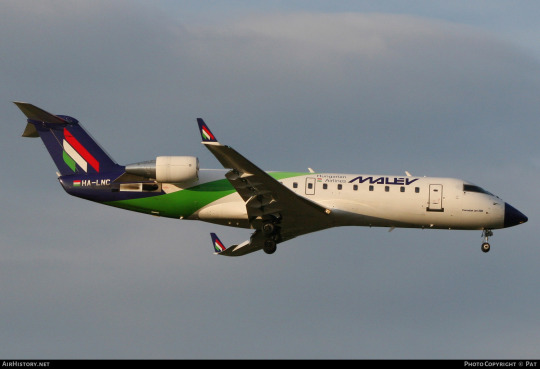
I love this little green swoosh upwards. Now, I think I would have chosen a different color for it - either a slightly lighter blue or maybe a darker green. I like how it tapers and fades towards the top. I like how it overlaps the bottom of the main blue section. I think it basically entirely solves the problem in an elegant way.

Unfortunately, this feature was used only on the CRJ-200 fleet. The CRJ is already a plane that's on the Lufthansa-proof side, particularly the shortest -200 variant, so it's a shame we didn't get to see this do some real legwork on a model that desperately needed it. Still, I think that Lufthansesque design could take notes from this, as it basically solves their issue! I don't get why this isn't something you see done. It's such a simple but satisfactory solution. Why, why did MALÉV not generalize this to their other planes?
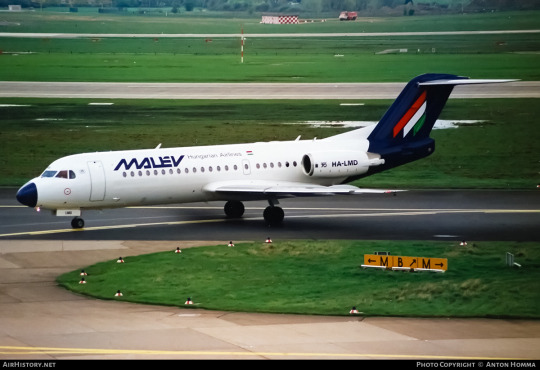
Wrapping up my thoughts is the most challenging part of this. Normally I try to judge liveries by their weakest link - Lufthansa or TAM don't get let off because their liveries look better on short planes. But there's enough about the design choices that were made by MALÉV that I keep resisting tossing them into that same pit.
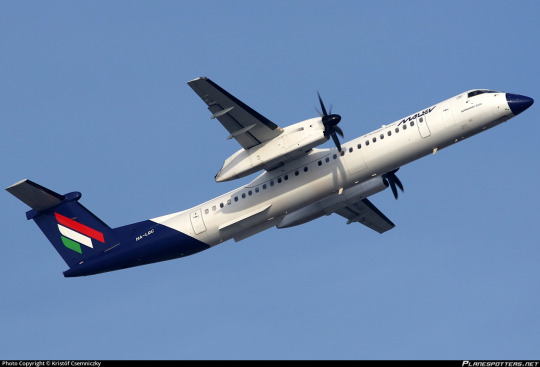
Nothing about MALÉV's livery really changes things drastically enough that it fundamentally deviates from the Lufthansa Line archetype, but it feels like the tiny tweaks change just enough that I actually think it's pretty okay. The painted nose, in particular, does a lot for me. I can't help but wonder if I'm being too kind to MALÉV because they operated so many pointy, angular, square airframes that really prevent the weaknesses of the Lufthansa Line from showing, and I try not to judge based on mitigating airframe factors if the airline operates types that aren't so lucky, but I just can't help but think the nose does add something very tangible, a sense of forward motion and a feeling of character that makes me hate it distinctly less, and the color choices are also nice!

And it's this feeling of character that keeps me...not really disliking this livery even though I will freely acknowledge it's lacking. There's something compelling accomplished just by painting the nose. I almost find that bizarre.

But, honestly...mostly white or not, I think these planes have enough color to them at the tarmac at Budapest wouldn't seem completely desolate. I think they'd go well with Wizz Air too. So, I mean...I think ultimately I like MALÉV, yes.
I'm going to give them a C+.
I can't justify going higher than that. But the main impression I've taken away is that I really wish MALÉV got a chance to overhaul their livery for the 2020s. What they had in their final phase actually looks quite contemporary, but that's because it was played out before it became an actual trend - introduced 1986, it predates even FedEx. I definitely can't rule out that whatever they redesigned this into would be worse, but as long as they kept the painted nose that's at least one thing I like a lot.

I've heard the Hungarian government would like to someday resurrect MALÉV if finances allow. To be clear, I do mean that I've heard it secondhand, but I can't find the actual source on it. This may be because I don't read Hungarian, but I think it would be nice to see. Even if there's a fifteen or even twenty-year gap, that's a better thing to see for a legacy which spans three-quarters of a century than for it to end there, and it's about time Hungary had a flag carrier again.

―――――――――――――――――――――――――――――――
Footnotes are so fantastic and useful. Why haven't I been using footnotes until now? I digress so much, why haven't I been making my posts more legible? I mean, tumblr unfortunately doesn't let you link to part of a post so they're not as useful as they are on other websites, but, like, no worse than endnotes in a book, right? And I deal with those all the time with very little grumbling.
[1] You can even still take a sightseeing flight on HA-LIX, or see her at airshows, where she looks fantastic for her 74 years of age (built 1949). She is operated by the Goldtimer Foundation on behalf of her owners, the Hadtörténeti Museum, still wearing the livery of her former operator, MALÉV. She even just got a round of restoration in early 2022, and is potentially the only airworthy Li-2 in the entire world of over 5,000 built, as it's thought the only other recent user, the North Korean Air Force, has mothballed theirs.
[2]: I saw multiple mentions of László Zsótér as the designer of this livery, but cannot find any mention of whether he worked for an outside agency or was in-house at MALÉV.
[3]: I mean, when you think about it, all of MALÉV's airplanes are painted birds.
[4]: ie, schemes that are also primarily red and green but include other color(s) like blue, yellow, or black - see Ethiopian Airlines or MEA for an example - as well as honestly color schemes that are just red and white or green and white. It's honestly as bad as red, white, and blue.
#tarmac fashion week#grade: c+#region: central europe#region: hungary#malév hungarian airlines#flag carriers#defunct carriers#requests#era: 1960s#era: 1940s#era: 1950s#era: 1970s#era: 1980s#era: 1990s#era: 2000s#era: 2010s#region: soviet bloc#lufthansa line
13 notes
·
View notes
Text
Brazil rules out renationalizing Eletrobras

Brazil is not considering the renationalization of former federal power holding Eletrobras, mines and energy minister Alexandre Silveira (in photo) told a seminar on Monday.
Silveira said the issue was closed when the government took the path of seeking proportional representation on the company's board, which is the subject of a case being heard by the federal supreme court.
The official said that, despite owning 43% of Eletrobras’ shares, the privatization model allows the government to have just one representative on its board.
“So, what we question is proportionality. We understand that there is a distortion in a very sensitive area for the country,” he said.
Continue reading.
#brazil#politics#brazilian politics#economy#energy#eletrobras#alexandre silveira#mod nise da silveira#image description in alt
1 note
·
View note
Text
The long French nuclear winter
The long French nuclear winter
Time is pressing, but the French nuclear park is taking longer than expected to get out of the rut. At the gates of winter, and with the cold beginning to take its toll, Electricite de France (EDF) —the electric giant about to be renationalized— has delayed the schedule for the reopening of nuclear reactors that have been stopped for months for repairs and overhauls. The inactivity of almost half…

View On WordPress
0 notes
Text
Working Class People United - Lynch

Working class people are united, remarks Lynch, and will not assimilate to Tory Party’s assault. Lynch says, working-class people, stand united as they will not be divided by the Tory Party’s class war. RMT’s Mick Lynch stressed this fact today. The cost of living crisis is manufactured on the grounds of plunging take-home pay and soaring inflation. The cost of living crisis came into much focus on profit over people.
Lynch addressing the Workers!
Lynch was addressing a fringe meeting on the Labour’s annual conference on an opening day. The conference at Liverpool where Lynch addressed the members of the party at the grassroots level. He also mentioned the union movement members to pressurize the leader Sir Keir Starmer. The need of ordinary people needs to be prioritized. National rail strikes are planned to happen over the attacks on pay and jobs. The union of the general secretary will hold more national rail strikes on the next two Saturdays.
Lynch’s claims!
He slammed the other newspapers from the other font. The feud among them envisioned the 4th Viscount Rothermere as a union baron. The world is now turned upside down. He addressed the meeting room full of people near the world-famous Albert Dock. People with laughter and applause came after his speech. The people who grew up in the council states are supposedly known as barons. The people who happened to be the barons are likely to have spoken up about the working people.
Working Class People United - Lynch
Labour Party and Lynch’s clam!
Lynch says they will not be divided. They promised to be with Labour members and the rest of the working movement. The working movement is fighting to retain public services and to reorganize to rebalance society. The societal model should align with the working class. Tory Ministers thought RMT would be isolated from the other rail unions, Labour Party, and the public. Lynch said they would crush us in weeks or within a couple of days.Tan Dhesi!Tan Dhesi, who comes with a commitment from the shadow railways minister also addressed the event. This process is to secure the renationalized network which was welcomed by the general secretary. Public Ownership is introduced to move forward. The rank-and-file of the Labour Party believes the same. They need this to keep the people in the top hall of the conference under pressure. The pressure does not just include the transportation facility but also from every ground that they might face further.
Liz Truss’s management
The aggravating problems like the increase in the energy crisis along with the overwhelming support for motions to renationalize. The main utilities need to renationalize at the conference held last year. Kier has rejected the calls to take on energy firms so far into public ownership. This move has a great opinion conscience from the political repertoire. The TUC survey confirms that workers’ rights need to be strengthened but Truss is venturing in the opposite direction.
Truss' Government Announcement!
Truss’ government has announced plans to curtail the militant trade unions. It includes very minimum service level requirements while strikes make them ineffective. Lynch addresses this move as hostile and will adapt as well. They are making it difficult almost impossible to carry on a lawful dispute. He says the union government needs to be involved in the same. He also questions that can be challenged in the courts, the workplace and on the streets.RMT’s backed initiative is to build up the Communicative Workers Union that has attracted thousands of people to rallies. This had continued across the country in recent weeks since the cost of living crisis seeped in.
For more information, please visit:
https://www.mirror.co.uk/news/politics/keir-starmer-cant-believe-luck-28078394
Read the full article
0 notes
Text
Why Choose Cognitive Behavioral Therapy for Anxiety & Depression
What is cognitive behavioral therapy?
Cognitive behavioral therapy (CBT) is a treatment approach that helps an individual recognize the negative or unhelpful thoughts and behaviors they have. The technique can help people find new ways to behave by changing their thought patterns.
I learned from a renowned CBT therapist near me that cognitive interventions usually seek to identify thoughts and beliefs that trigger emotional and behavioral reactions. A person with anxiety, for instance, can think that if they make even a small error, everyone would notice and reject them, making them feel unworthy.
I recently learned from a friend who works with a top TMS specialist close to me how CBT might assist someone in subjecting his or her beliefs to rational analysis and help them create more adaptable beliefs.
Why CBT for anxiety and depression?
A renowned Cbt Therapist Los Angeles claims that CBT may encompass challenging depressive thought patterns that result in inaction or self-harming acts. CBT is favored because it can alter someone's sentiments because ideas and actions can impact one another. CBT does this by focusing on both thoughts and actions. The following are some of the factors that make CBT the best treatment for depression and anxiety:
Ability to change depressive thinking patterns
CBT encourages the patient to question and defend their unfavorable views, thereby lowering the influence they hold over them. In order to lessen cognitive distortions, techniques like cognitive restructuring are utilized to comprehend the patient's thought patterns, the emotion or trigger that underlies the thought patterns, and the actual realistic viewpoints.
Improvement of energy and motivation
According to the information I obtained from a renowned psychiatrist in Los Angeles, CBT techniques that include praising oneself for tiny behavioral adjustments are quite helpful in treating anxiety and depression. An human alters the chemical activity in their brain by rewarding themselves for performing a task. A reward increases the likelihood that a person will repeat the activity in the future.
Learning of cognitive distortions and unhealthy thought patterns
With the aid of CBT, a person can learn about any potential cognitive distortions and unhealthy thought patterns that may be escalating depressive feelings or suicidal thoughts by challenging their thought patterns, tone, and self-talk. A premier TMS center in Long Beach has reported that cognitive restructuring, a crucial treatment for anxiety and depression, aids in the formation of healthy patterns, the reduction of cognitive errors, and the practice of techniques for renationalizing distortions.
Effective thought journaling
At a recent session I went to, a TMS center in Long Beach skillfully explained the idea of thought journaling. I discovered at the conference that keeping a journal about one's feelings, thoughts, and behaviors gives the writer space to process their experiences, spot any potential triggers, and understand how their thoughts affect their behavior. As a result, they may be more able to develop future coping mechanisms for anxiety and despair.
Need help with cognitive behavioral therapy for anxiety and depression?
If you need any information or help with cognitive behavioral therapy for anxiety and depression, call (562) 203-0567 or send your inquiry here and you will be assisted.
0 notes
Text
Temporarily renationalize energy companies that fail to cut their bills, says Gordon Brown
Temporarily renationalize energy companies that fail to cut their bills, says Gordon Brown
It is the latest in a string of high-profile interventions from Mr Brown, who has also called for an emergency budget ahead of the choice of the next prime minister and daily meetings of the government’s Cobra committee.
The latter idea was dismissed by Oliver Dowden, the former Tory chairman, who said: “I’m not taking huge lessons from Gordon Brown, remember he was a man who gave us a 75p raise…

View On WordPress
0 notes
Text
France Will Spend Nearly $10 Billion to Renationalize EDF
France Will Spend Nearly $10 Billion to Renationalize EDF
France plans to pay 9.7 billion euros, about $9.8 billion, to fully renationalize EDF, the state-backed electricity giant, in a move that the government said would allow it to bolster the country’s energy independence, overhaul its nuclear power program and invest in renewables.
The French Finance Ministry said on Tuesday that it would offer EDF shareholders €12 per share for the roughly 14…
View On WordPress
0 notes
Text
The state announces a takeover bid worth 9.7 billion euros for the renationalization of EDF.
The state announces a takeover bid worth 9.7 billion euros for the renationalization of EDF.
The government “institutionalises bonuses as a means of reward”, denounces Fabien Roussel
National Secretary of the French Communist Party, Fabien Roussel, was a guest of the “4 Truths” program on “France 2”. He returned to yesterday’s debates in the National Assembly and stopped when the first of the twenty articles was not yet voted on. “We all want it to go forward (…) No one is against…

View On WordPress
0 notes
Text
France and the big nuclear energy mistake
France and the big nuclear energy mistake
The French government wants to expand nuclear production in France and it also wants EDF to spend big money on the rehabilitation of numerous nuclear power generating stations. It has put pressure on EDF to embrace those policies and we suspect that it could force the issue as the majority shareholder.
France plans to renationalize EDF, its giant utility. That doesn’t sound like a big deal…

View On WordPress
0 notes
Video
youtube
Gustavo Petro was elected as the first leftist president of Colombia this past Sunday, upsetting long-time supporters of the extreme right wing in the country. Ana Kasparian and Wosny Lambre discuss on The Young Turks. Watch LIVE weekdays 6-8 pm ET. http://youtube.com/theyoungturks/live Read more HERE: https://www.theatlantic.com/ideas/archive/2022/06/colombia-presidential-election-duque-petro/661335/ "Which would you prefer? An elderly TikTok star who compares himself to Donald Trump? Or a former Marxist guerrilla who attended the funeral of Hugo Chávez? A candidate notorious for his radical flip-flops on public policy? Or a candidate notorious for his intolerance of any kind of disagreement or dissent? One who explained his praise for the Hitler dictatorship by claiming he had confused Adolf Hitler with Albert Einstein? Or one whose attempt to renationalize garbage collection in his city left mountains of trash piled in the streets? Welcome to the Colombian presidential election of 2022. The second round of voting last night yielded a victory for candidate No. 2, the former guerrilla Gustavo Petro, over No. 1, Rodolfo Hernández. Obviously, either choice would have inscribed huge question marks over the future of one of the more successful democracies in Latin America. But there’s another question mark, a retrospective one: How in the world did Colombia arrive at such a bizarre dilemma? Colombia’s outgoing president, the moderate conservative Iván Duque Márquez, was barred from running again by the country’s strict single-term limit. In that four years, he oversaw a record of policy success unmatched in recent South American history. In return, he is leaving office with an approval rating in the low 20s, the worst any president has had in Colombian polling history. The party he belonged to has been wrecked and discredited. I interviewed Duque on June 2, during a visit he made to Washington, D.C., and found him as baffled as anybody else by Colombia’s turn to extremism." *** The largest online progressive news show in the world. Hosted by Cenk Uygur and Ana Kasparian. LIVE weekdays 6-8 pm ET. Help support our mission and get perks. Membership protects TYT's independence from corporate ownership and allows us to provide free live shows that speak truth to power for people around the world. See Perks: ▶ https://www.youtube.com/TheYoungTurks/join SUBSCRIBE on YOUTUBE: ☞ http://www.youtube.com/subscription_center?add_user=theyoungturks FACEBOOK: ☞ http://www.facebook.com/TheYoungTurks TWITTER: ☞ http://www.twitter.com/TheYoungTurks INSTAGRAM: ☞ http://www.instagram.com/TheYoungTurks TWITCH: ☞ http://www.twitch.com/tyt 👕 Merch: http://shoptyt.com ❤ Donate: http://www.tyt.com/go 🔗 Website: https://www.tyt.com 📱App: http://www.tyt.com/app 📬 Newsletters: https://www.tyt.com/newsletters/ If you want to watch more videos from TYT, consider subscribing to other channels in our network: The Damage Report ▶ https://www.youtube.com/thedamagereport Indisputable with Dr. Rashad Richey ▶ https://www.youtube.com/indisputabletyt Watchlist with Jayar Jackson ▶ https://www.youtube.com/watchlisttyt TYT Sports ▶ https://www.youtube.com/tytsports The Conversation ▶ https://www.youtube.com/tytconversation Rebel HQ ▶ https://www.youtube.com/rebelhq TYT Investigates ▶ https://www.youtube.com/channel/UCwNJt9PYyN1uyw2XhNIQMMA #TYT #TheYoungTurks #BreakingNews 220621__TB02 by The Young Turks
0 notes
Text
Why does the government want to renationalise EDF?
Why does the government want to renationalise EDF?
Maud Descamps
06:09, June 15, 2022
A renationalization of EDF to allow it to build new nuclear reactors has not yet been decided, but it “is not excluded”, said Minister of Energy Transition Agnès Pannier-Runacher on Europe 1 on Tuesday. the electricity giant, the State will have to pay between 5 and 6 billion euros.
This is an announcement that has not gone unnoticed. The state does not rule…
View On WordPress
0 notes
Photo

req’d by @catsarehumanstoo
i dont know what that even means but i guess you can try?????
141 notes
·
View notes
Text
Suspended the negotiation of EDF pending information on the renationalization
Archive – Photovoltaic self-consumption – EDF FENICE – Archive
The negotiation of the shares of Électricité de France (EDF) on the Paris Stock Exchange has been suspended this Wednesday at the request of the company itself due to the information on the renationalization of the company and pending a statement in this regard from the French Government.
“Following the Prime Minister’s announcements…
View On WordPress
0 notes
Note
at what age did you know you wanted to write? and what age did you know you wanted to share your writing online? were there definitive moments for either? and do you have recs on how to go about finding a beta, bc i'm completely oblivious, and i'm not sure if it should just happen organically or by offer or if there's several 'ways' to find a beta, rip.
I always like writing, but I was super self-conscious and never let anyone read it, but I always told myself someday. So then, I was doing this personal challenge thing and I really wanted to force myself to write a full story, but I always burned out and gave up because I’d just doubt whether it was interesting to anyone but me, so I decided that I’d make myself do it by writing a fanfic, because I renationalized that if strangers on the internet hated my writing I’d be able to dump the pseud and move on, but if I let someone IRL read my stuff and they told me it was garbage I’d feel hurt towards them until the day I died.
So I started out beta-less and found all my betas because they commented/messaged me to let me know about misused words/typos in my fics. Apparently this isn’t the normal way. People can ask for a beta in the various fandom fb groups, or if you join some of the fandom discord servers, and there are usually channels for pitching your fic and asking if anyone is interested in beta’ing it.
7 notes
·
View notes